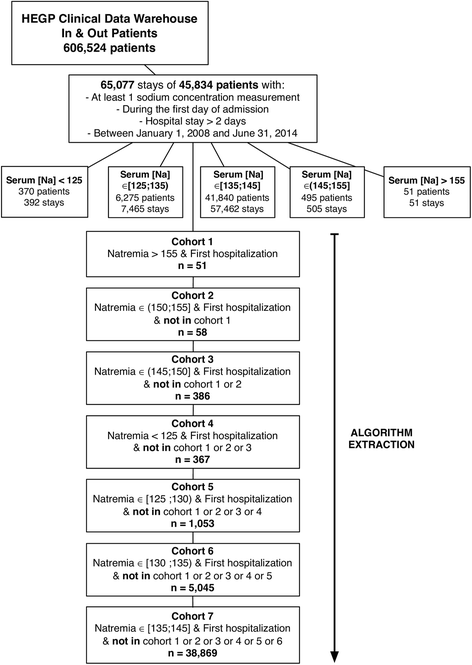Association between borderline dysnatremia and mortality insight into a new data mining approach
- PMID: 29166900
- PMCID: PMC5700671
- DOI: 10.1186/s12911-017-0549-7
Association between borderline dysnatremia and mortality insight into a new data mining approach
Abstract
Background: Even small variations of serum sodium concentration may be associated with mortality. Our objective was to confirm the impact of borderline dysnatremia for patients admitted to hospital on in-hospital mortality using real life care data from our electronic health record (EHR) and a phenome-wide association analysis (PheWAS).
Methods: Retrospective observational study based on patient data admitted to Hôpital Européen George Pompidou, between 01/01/2008 and 31/06/2014; including 45,834 patients with serum sodium determinations on admission. We analyzed the association between dysnatremia and in-hospital mortality, using a multivariate logistic regression model to adjust for classical potential confounders. We performed a PheWAS to identify new potential confounders.
Results: Hyponatremia and hypernatremia were recorded for 12.0% and 1.0% of hospital stays, respectively. Adjusted odds ratios (ORa) for severe, moderate and borderline hyponatremia were 3.44 (95% CI, 2.41-4.86), 2.48 (95% CI, 1.96-3.13) and 1.98 (95% CI, 1.73-2.28), respectively. ORa for severe, moderate and borderline hypernatremia were 4.07 (95% CI, 2.92-5.62), 4.42 (95% CI, 2.04-9.20) and 3.72 (95% CI, 1.53-8.45), respectively. Borderline hyponatremia (ORa = 1.57 95% CI, 1.35-1.81) and borderline hypernatremia (ORa = 3.47 95% CI, 2.43-4.90) were still associated with in-hospital mortality after adjustment for classical and new confounding factors identified through the PheWAS analysis.
Conclusion: Borderline dysnatremia on admission are independently associated with a higher risk of in-hospital mortality. By using medical data automatically collected in EHR and a new data mining approach, we identified new potential confounding factors that were highly associated with both mortality and dysnatremia.
Keywords: Borderline dysnatremia; Electronic health record; Hypernatremia; Hyponatremia; In-hospital mortality; Phenome-wide association analysis; Sodium.
Conflict of interest statement
Ethics approval and consent to participate
This study was approved by the institutional review board of the HEGP (IRB#00001072 Study #CDW_2015_0013).
Consent for publication
All persons gave their informed consent prior to their inclusion in the study.
Competing interests
The authors declare that they have no competing interests.
Publisher’s Note
Springer Nature remains neutral with regard to jurisdictional claims in published maps and institutional affiliations.
Figures
References
Publication types
MeSH terms
LinkOut - more resources
Full Text Sources
Other Literature Sources



